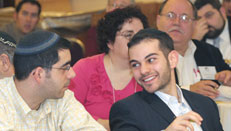 |
 Food being dipped, glasses being filled, the religiously fervent talk of our side finally achieving victory after having been downtrodden for so long - sounds like it's playoff time.
Or Seder time, an exercise in vague discomfort for many Jews who confide that they can't wait to get through the "religious stuff" in the Haggadah to arrive at the real focus of the evening - the meal. But the Seder was created to provoke curiosity rather than become one. More than a history lesson or a tribute to God's might, the Seder is trying to model the art of asking a question. Rabbi Joseph Soloveitchik points out that we are trying to inculcate in our children and also in ourselves the spirit of inquiry. Because God, he says, needs to be sought out; part of what it mean to grow Jewishly is to develop the mindset of actively pursuing things rather than passively ingesting them.
So why have many Seders become so uninspiring? For one thing, because we have not learned to ask our own questions, to translate the Jewish story of liberation into ideas that will be real for each person at the contemporary table. The Haggadah is attuned to an age when Jews were fully informed of the laws of Judaism and hence the Jewish child would instantly notice the change in the daily religious routine. Because this is often no
longer true, the rituals that were designed to incite comment have ceased to be understood. To many people, unfortunately, they seem utterly arbitrary, if not bizarre, as though you could just as well take horseradish and throw it against the wall; kids would ask about that too. Even in religious households the Seder can become a static affair, each year bringing many of the same discussions.
Yet the Seder should be an exciting event, because it probes one of the fundamental tensions within reality, which is that human beings can be physically free and yet at the same time a slave to something. One can see this tension even in a very small ritual such as Yachatz, which derives from the Hebrew word "half." There are three matzot on the Seder plate; in Yachatz, the Seder leader takes the middle matzah and breaks it into two unequal pieces.
On the one hand, these pieces can represent slavery. Because only somebody poor, destitute, cuts his food in half and saves it for another time. In Survival in Auschwitz, Primo Levi recalls the problem that everyone in the camp had every day - what do we do with our incredibly meagre ration of food when we get it? Do we eat it right away in the morning or do we put a little bit away for the afternoon. This is Yachatz, the calculation of how to stave off hunger, the action that a poor person makes. In this version, the breaking of matzah is equated with slavery. But another way of understanding Yachatz is as a symbol of liberation. How? Breaking bread is also a sign of sharing. When you divide up your food into two, this immediately invites other people to participate in your bounty. It's a kind of invitation. By dividing your food, you're already saying I'm not an island unto myself.
Questions abound, especially ones that could be real for children. Why would you break your food in half? What's the last time you shared something with somebody? Was it hard to do? What would you never share no matter how much your friend asked you? What happens to all the food in the world that we don't eat? When we wake up, where do our dreams go?
|
 |








